Advanced Analytics Reveal Which D-Linemen Broncos Should Pursue in Free Agency
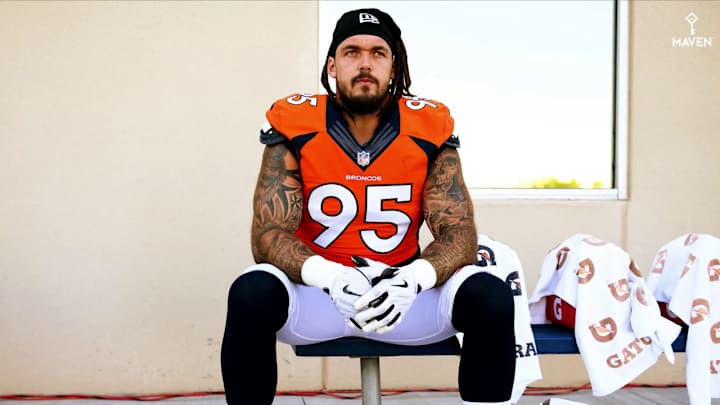
Rumors are running rampant when it concerns which free agents the Denver Broncos will sign to fill holes along their defensive line. Fans and analysts alike are delivering opinions in rapid-fire, but rare are those opinions based on analytics.
Now is a great time to provide those analytics by including the front seven (linebackers and defensive linemen) players in continuation of the NFL free agent analysis found in the two previous articles on wide receivers (skill positions) and cornerbacks.
This continuation of the analysis will answer the same two questions that were answered in the previous articles that included the skill positions and defensive backs.
At what age does a player’s performance rapidly decline? Does it vary by position?
The next series of graphs include defensive backs from the first analysis to use as a comparison for the defensive linemen and linebackers in this article.
The first graph depicts the average Performance Value by age. This is the first time in the analysis that a position group peaks at 29 years old, the oldest peak age. Defensive linemen peak at age 29, while linebackers peak at age 26.
However, defensive linemen fall into rapid decline after their peak age while linebackers tend to perform near their peak season for three more years.
(Note: only ages with at least 15 players who played at that age are included in the below graph)
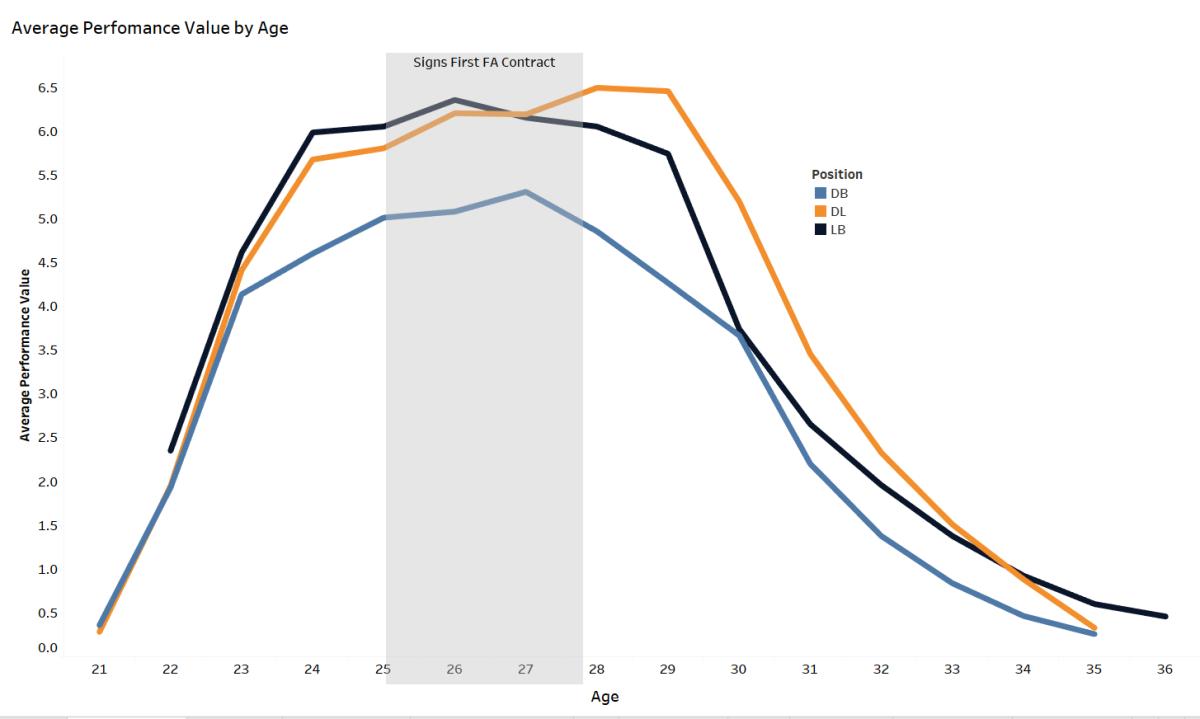
The next graph is a scatter plot depicting every player in the data set, at every age they played and the difference from the mean at their position for each of those ages.
DL and LBs enjoy a longer and more productive career as they age and there are many examples of several players with a Performance Value greater than the position mean after age 30.
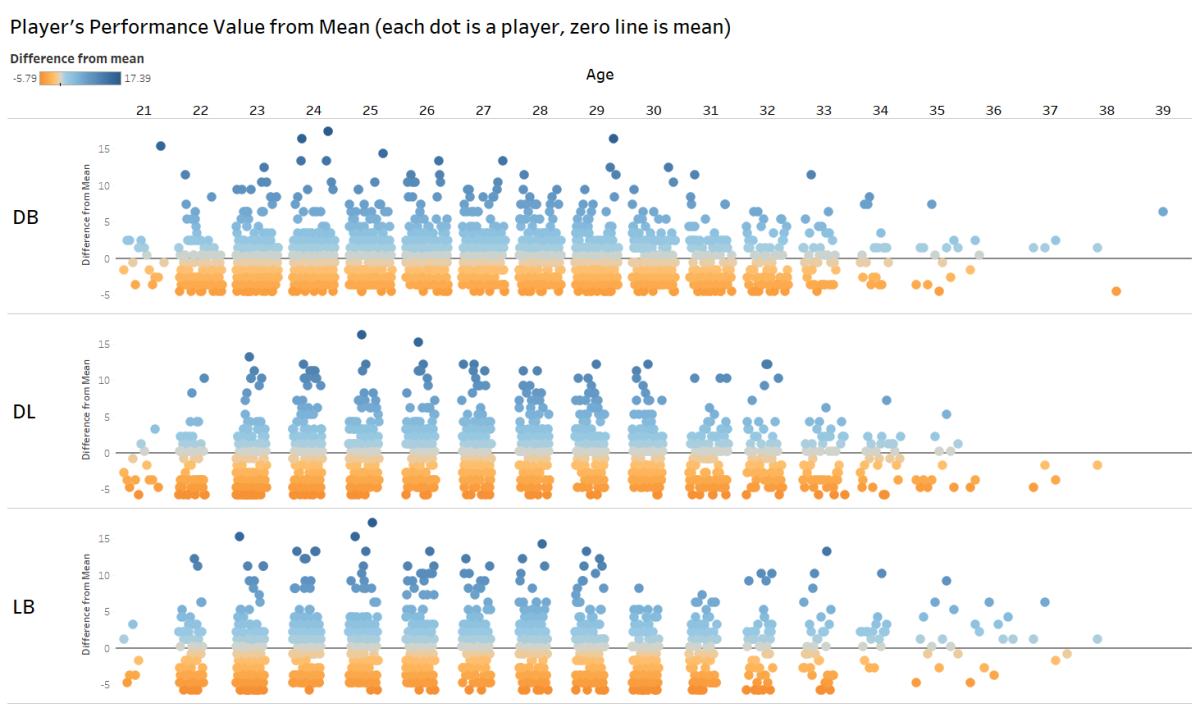
The next part of the analysis compares a player to his own performance throughout his career. In this part of the analysis, each player is compared to his mean performance over his entire career.
The following graph is another scatter plot that shows each player by his age and the difference in his Performance Value for that season versus his mean.
Similar to DBs, LBs can have performance above their mean well into their 30s and all position groups have players with higher than their mean Performance Value after 30. However, it is a rarity for a DL to perform above his mean after age 32.
Again, more evidence of rapid decline in the Performance Value of DL after their peak.
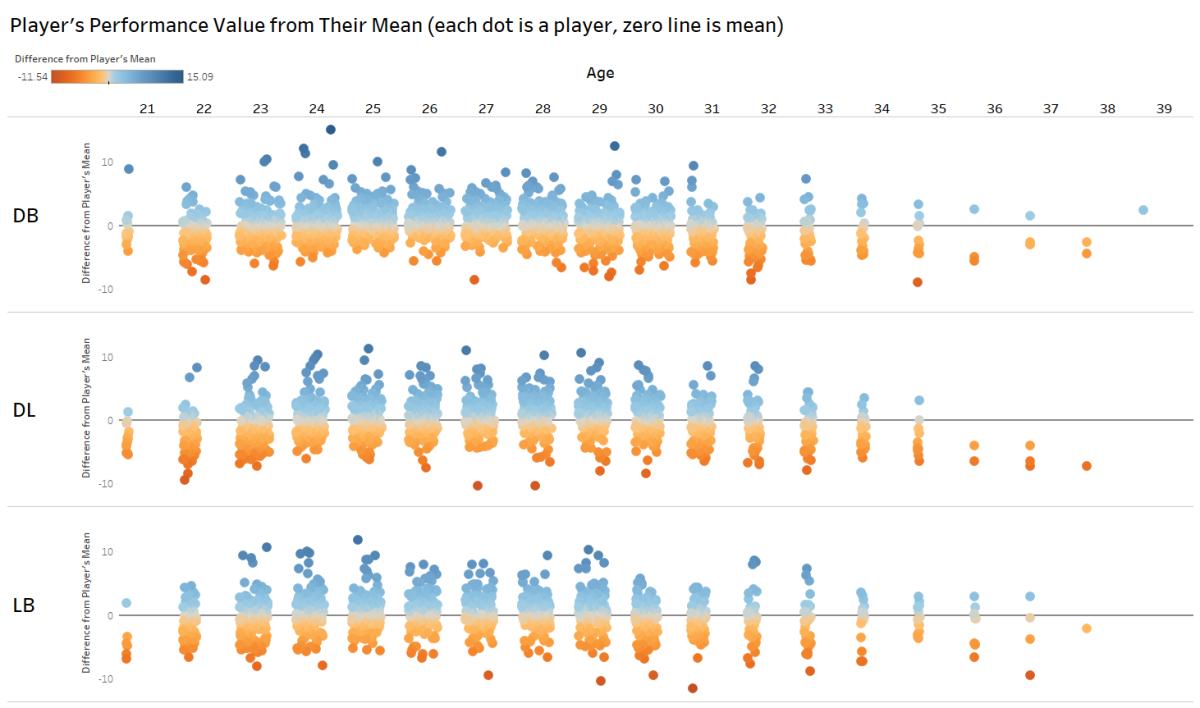
The next graph depicts the difference in a player’s Performance Value versus his mean. Again, DL performance peaks at 29 years old, but drops off rapidly after.
However, this is the first position group that has a Performance Value above their mean after 30 years old. LBs peak at 26 years old and decline slowly until age 29, then rapidly decline.
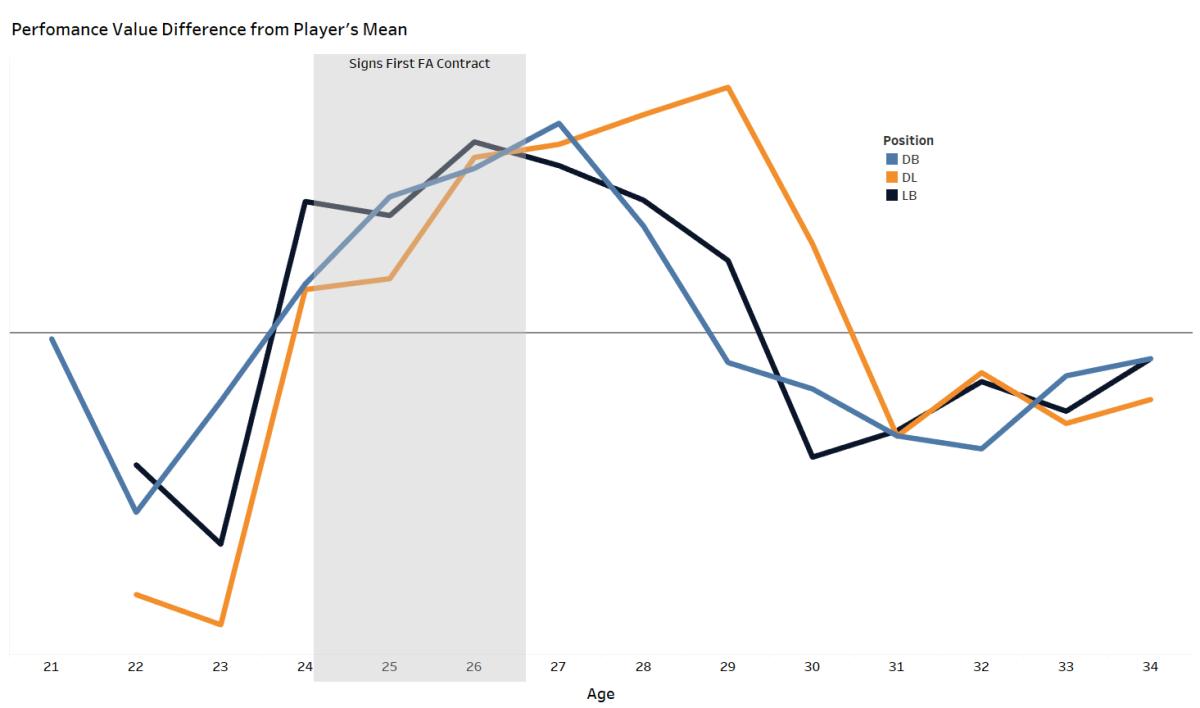
When looking at a free agent LB, it would be smart for a team to offer a contract to a player who is 25 or 26 because that player will more than likely have a peak season during that contract or continue to perform at a level near the peak for three years after signing. At 29 years old, offering a contract is a significant risk that likely will not see a good return on the investment.
A DL free agent will likely have his peak season after he signs his first contract. If the player signs that first contract at age 26, the signing team will be rewarded with not only a high level of play for the next three years, it is more likely than not that the team will see said player’s peak season. That is a significant return on investment.
When a DL is at age 29, it is a much bigger risk to offer said player a contract of any significant length or of high dollar value because that player will likely decline rapidly in performance after pen is put to paper on the contract.
Applying the Data to the 2020 DL Market
With this analysis in mind, let’s do a deeper dive into the current DL free-agent market.
Within the data there have been 43 DL who started their career at 24 years old or less, played at least eight seasons, had a Performance Value at least 2.5 times the position mean between the ages of 25 and 29, and played after their peak season.
26 (60%) of those players were able to repeat that performance level (within 75% or greater) at least once during the next two seasons. Meaning, those players not only ascended to a high level right before or during their first free-agent contract, they maintained that level of play. They avoided the “flash in the pan” monikers.
There are only three current unrestricted free-agent DL who have met this criterion. Chris Jones, Leonard Williams, and Danny Shelton.
Jones is going to get the franchise tag from Kansas City. Williams actually had his peak season at age 22 and although he followed it up with solid seasons, he appears to be declining in performance, not ascending. Williams' estimated market value is high and with his declining performance, that is a risky investment.
Shelton is either ascending in performance or had a fluke season last year at age 26. The data indicates he is more likely to follow up that peak season with at least one season of similar performance in the next two years. The future isn’t easy to predict, but leading up to the NFL Draft, Shelton appeared to be a solid prospect.
By most analysts' profiles, Shelton was a first-round draft choice, meaning he has skills. He hasn’t lived up to his draft status, but the data shows that DL are late bloomers.
Shelton could be an example of a player who struggled early only to put it all together to have a solid career. His price tag is also very reasonable so the risk is mitigated by a lower cost. The Denver Broncos could get a significant reward by signing him.
There are four unrestricted free agent DL who may not fit the exact criteria explained above, but the data shows they are likely to have solid future seasons. They are Arik Armstead, D.J. Reader, Javon Hargrave, and Jordan Phillips.
The quartet all come with significant differences in the estimated contract value. Starting with Armstead at the top, followed closely by Hargrave, then Reader, and finally at a much lower cost, Phillips. All four are more likely than not to provide the Broncos with a solid return on their investment.
There is one sleeper to keep an eye on and that is Tyeler Davison. He won’t be signing his first free-agent contract since he was an unrestricted free agent last offseason and signed a one-year deal with the Atlanta Falcons. Davison will turn 28 during the season and will come at low cost. He is another player who may have need development before having a breakout season.
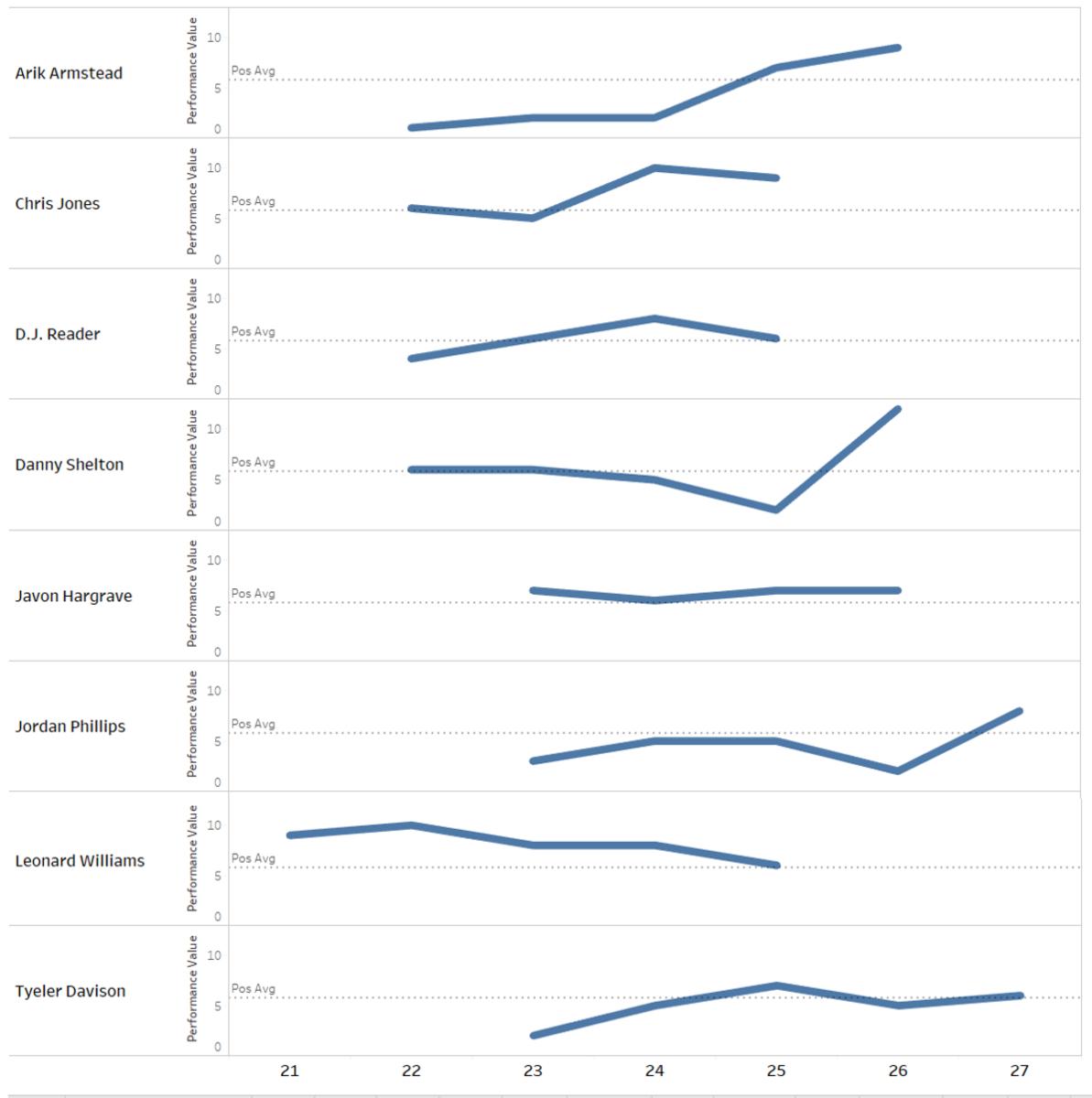
Homegrown Considerations
The Broncos also have a decision to make on three homegrown DL; Shelby Harris, Adam Gotsis, and Derek Wolfe. Gotsis had a peak season at 26 years old, but it wasn’t a significant season.
The other three seasons that he has played have been well below the average. He could put it all together and ascend to a level that we are not expecting, but that is not likely.
Harris is a bit of a conundrum. He has played sparingly all his career and at age 25 he was not playing at all. His Performance Value has been well below average until last season.
Harris is going to be 29 years old. He is more of a risk to sign to a large contract because the chances of him having good to great seasons over the life of the contract are not high.
Wolfe has been a very solid player over his career, only twice falling below the position average. However, he is turning 30 years old with a significant injury history.
The data suggests that he will decline in performance. Having him finish his career as a member of the Broncos would be a good story, but to offer him a contract of significant value or length would be ill-advised.
In the end, all three should be allowed to test the market.
Next up: Offensive Line
Follow Thomas on Twitter @ThomasHallNFL and @MileHighHuddle.
